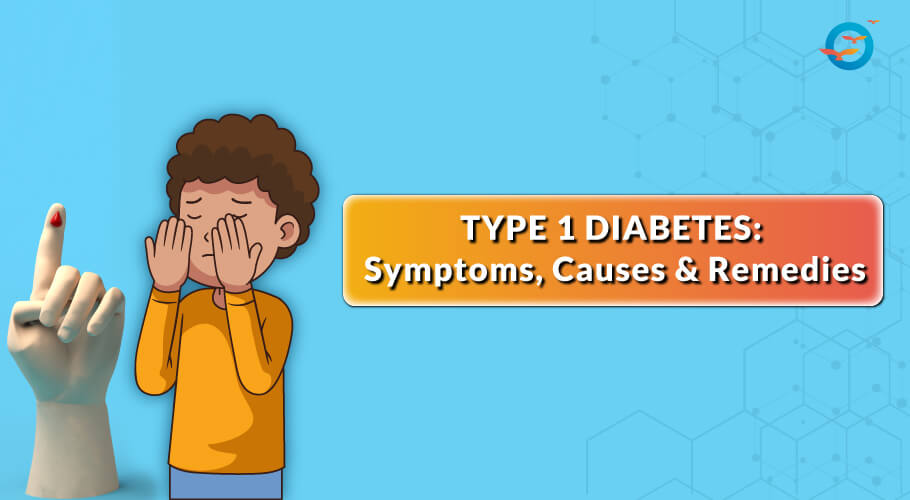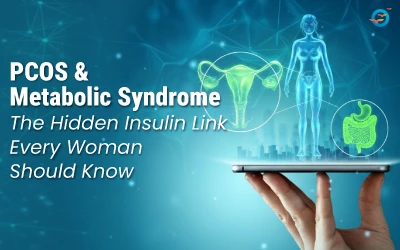Type 1 Diabetes: Symptoms, Causes and treatment - FFD

Diabetes in simple words is a metabolic disease indicated by elevated levels of blood glucose or blood sugar. If untreated, it can lead to serious complications like damage to the blood vessels, heart, eyes, kidneys, and nerves.
According to the statistics, 537 million adults ranging between the ages of 20-79 years are living with diabetes presently, including both Type 2 Diabetes and Type 1 diabetes. And the total number of diabetics is projected to rise significantly to 643 million by 2030.
There are different types of diabetes like -
- Type 1 Diabetes
- Type 2 diabetes
- Gestational diabetes
- Latent Auto-Immune Diabetes in Adults (LADA)
- Maturity Onset Diabetes of the Young (MODY).
This article looks at different aspects of type 1 diabetes.
What is Type 1 Diabetes?
Type 1 diabetes is a chronic condition in which the pancreas produces very little to no insulin. Type 1 diabetes (aka, juvenile diabetes or insulin-dependent diabetes), usually develops in children, young adults and teens. It can happen at any age. Type 1 diabetes is less common than type 2. Only 5-10% of people with diabetes have type 1.
Causes of Type 1 diabetes
Type 1 diabetes is the result of an autoimmune reaction wherein the body attacks itself by mistake. In the process, it destroys the insulin-making cells in the pancreas called beta cells.
A trigger, like a virus in the environment, can also play a part in developing type 1 diabetes. Interestingly, lifestyle habits and diet do not cause type 1 diabetes.
The Difference Between Type 1 and Type 2 Diabetes
The main difference is that type 1 diabetes is a genetic disorder that shows up in the early years of life and type 2 diabetes is largely lifestyle-related that develops over time.
Symptoms of Type 1 Diabetes
It may take time to develop clear signs and symptoms of Type 1 diabetes, but the most common ones are as follows:
- Frequent urination
- Increased thirst
- Bed-wetting in children especially during the night
- Weight loss
- Extreme hunger
- Mood changes and irritability
- Weakness and fatigue
- Blurred vision
Complications of Type 1 Diabetes
The 2 common complications of type 1 diabetes are hypoglycemia and diabetic ketoacidosis and one needs to know how to handle them.
Hypoglycemia or low blood sugar can happen very quickly in type 1 people and the causes could be :
- Too much insulin.
- Long waiting for a snack or a meal.
- Not eating enough.
- Doing extra physical activity.
In such cases, one needs to talk to your doctor to get the treatment plan changed.
Diabetic Ketoacidosis (DKA) is a serious complication of diabetes that can lead to death too. This develops when you don’t have enough insulin to allow blood sugar into your cells. Low insulin levels and very high blood sugars lead to DKA. Illness and missing insulin shots are the main reasons for suffering from it. One needs to talk to their doctor to properly understand how this situation can be prevented and treated.
Diagnostic Test for Type 1 Diabetes
The defining test for type 1 diabetes is the C-peptide test. C-peptide is co-secreted with insulin by the pancreatic beta cells in the form of pro-insulin. Low C-peptide identifies patients with type 1 diabetes. The ideal range of C-peptide is fasting >1, PP>2.5. Results of C-peptide, fasting, and PP are needed to diagnose whether one has type 1 diabetes or not.
In a nutshell: C-peptide fasting should not be less than 0.3 and C-peptide PP, less than 1.
Can type 1 diabetes be cured?
Type 1 diabetes cannot be reversed fully. But there are several cases where type 1 insulin patients have improved with proper diet and exercise. The important point is if your child's C-peptide fasting is >0.3 you can get very good results. If it is less, then the dose of insulin can reduce. Keep in mind that total stoppage of insulin is difficult in type 1, but with proper treatment, the results are very encouraging.
Type 1 diabetes treatment
The Type 1 diabetes treatment consists of the following
- Taking insulin
- Monitoring consumption of carbohydrates, fat, and protein
- Frequently monitoring blood sugar levels
- Eating healthy foods
- Getting regular exercise
- Maintaining healthy weight
Realistic aims for type 1 diabetics
- Better sugar control. Better HbA1c
- Avoidance of complications in the long run
- Reduction of insulin dose if C-peptide fasting is >0.3 and PP>1 there is scope for dramatic reduction of insulin and in rare cases stoppage
Conclusion -
The goal of a type 1 diabetic should keep your blood sugar level as close to normal as possible to prevent complications.
For more information on diet, exercise, stress management, and proper medical care subscribe to our Facebook, Instagram, and YouTube channels.
Read FAQ on this topic:
-
What are the early symptoms of Type 1 diabetes?
Early symptoms include excessive thirst, frequent urination, unexplained weight loss, fatigue, and blurred vision. -
What causes Type 1 diabetes?
Type 1 diabetes is caused by the immune system attacking insulin-producing cells in the pancreas, often triggered by genetic and environmental factors. -
How is Type 1 diabetes treated?
Treatment involves daily insulin therapy, blood sugar monitoring, a balanced diet, regular exercise, and consistent medical care.

